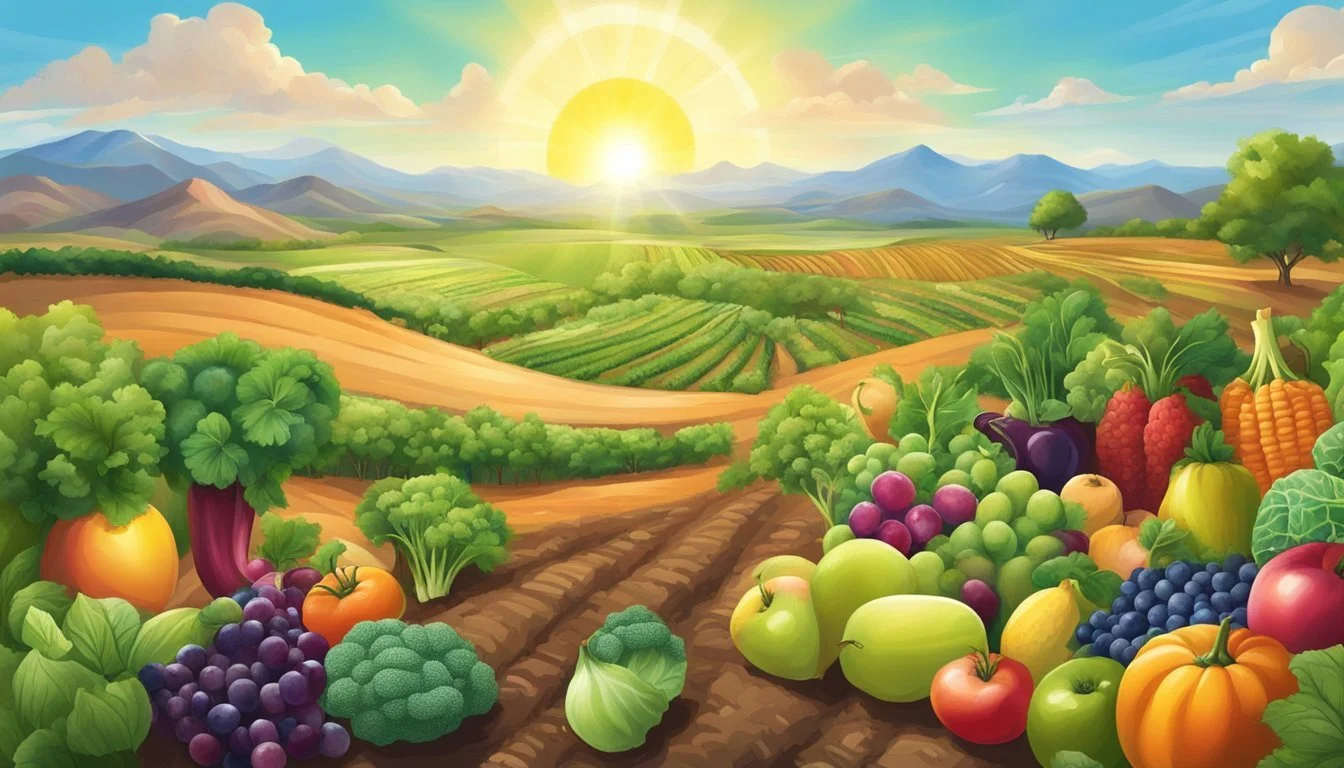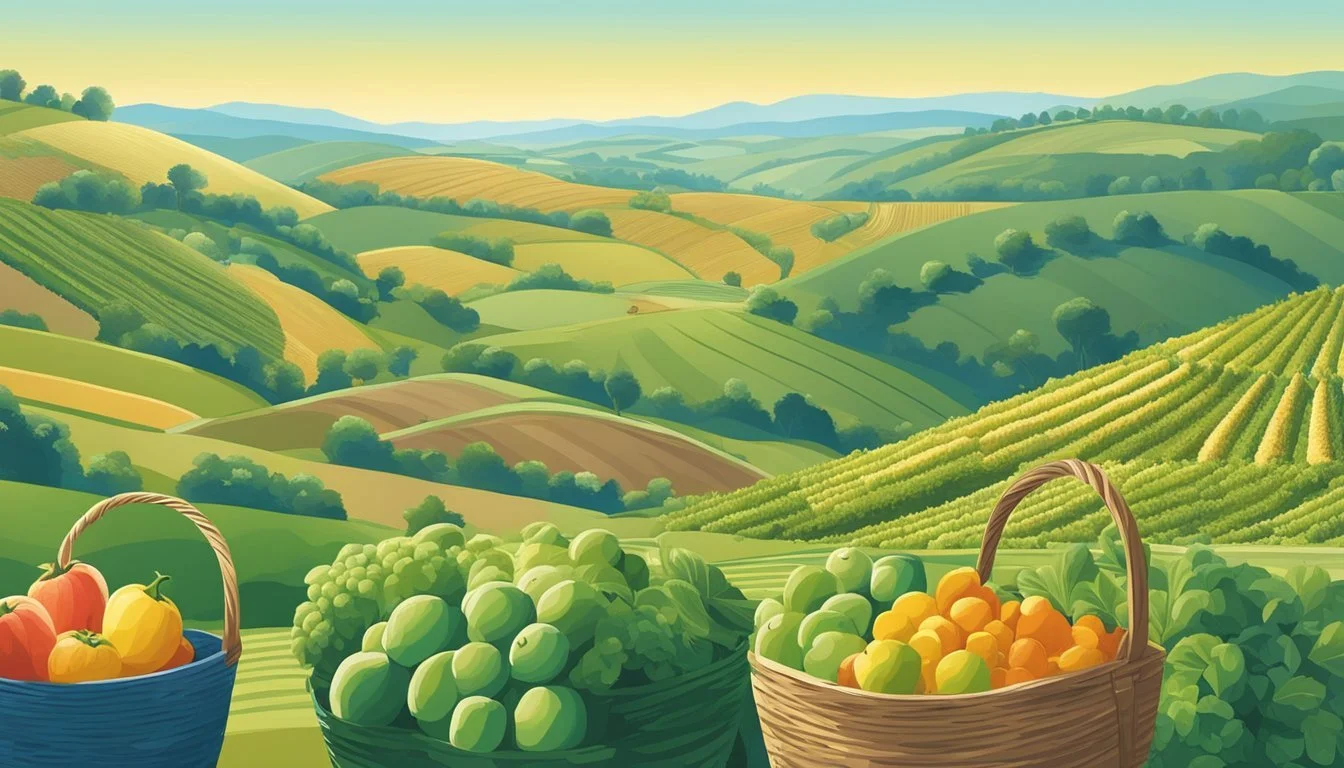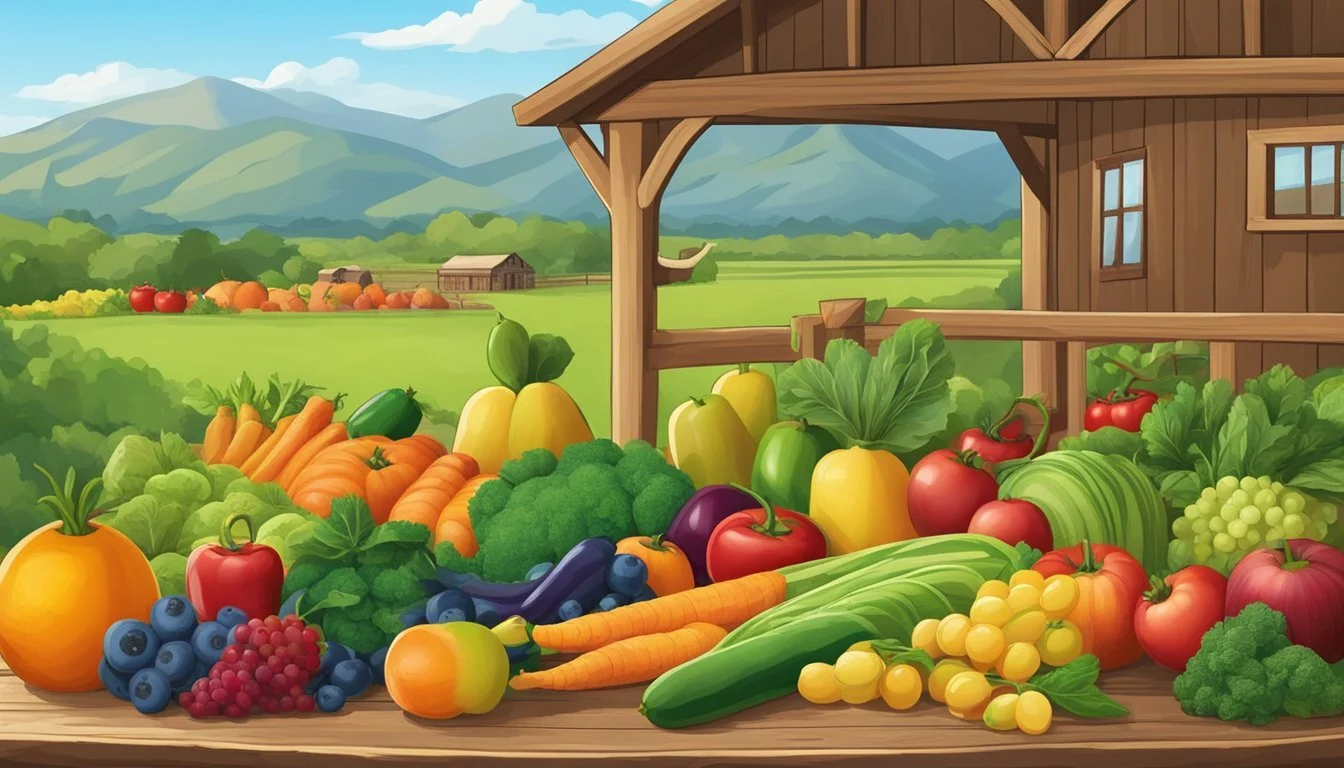Utah Seasonal Fruit & Veg Guide
Your Essential Calendar
Embracing the farm-to-table movement, Utah offers a rich tapestry of seasonal produce that reflects the state's diverse climate and fertile soils. Enthusiasts of fresh, locally-sourced fruits and vegetables have the opportunity to experience a flavorful journey through the year. From the tender spears of asparagus in May to the hearty harvest of carrots (how long do carrots last?) in November, Utah's agricultural calendar is thoughtfully aligned with the changing seasons.
The guide to Utah's seasonal fruits and vegetables serves as a comprehensive map for both consumers and chefs striving to incorporate the freshest ingredients into their culinary creations. As berries ripen in the warmth of June and July, and root vegetables respond to the cool embrace of autumn, Utah's farmers markets and restaurants alike showcase the best of what the season has to offer.
Understanding the ebb and flow of Utah's produce is essential for those seeking a farm-to-table lifestyle. This not only supports local agriculture but also ensures that the fruits and vegetables gracing tables are at their peak for flavor and nutrition. Whether one is crafting a vibrant summer salad or a robust fall stew, the guide to seasonal produce is an invaluable resource for making the most of Utah's bountiful harvests.
What’s in Season in Utah Right Now?
Understanding Local Agriculture
In the state of Utah, agriculture is shaped by the distinct climate and soil conditions as well as the diversity of its farming regions. Sustainable practices are integral to the longevity and success of Utah's agricultural sector.
Utah's Climate and Soil
Utah's climate is predominantly semi-arid to arid, with variations that arise from its topography. It's known for having low humidity and significant temperature fluctuations between day and night, which can broadly impact the types of crops that thrive. The soil composition ranges from the fertile alluvial soils in the mountain valleys to the more challenging clay-based soils found elsewhere, necessitating knowledgeable soil management to optimize crop yields.
The Farming Regions of Utah
The state is geographically diverse, contributing to a variety of farming regions:
Northern Utah typically sees a longer growing season and is favorable for crops like peaches, apples, and cherries (how long do cherries last?).
Central Utah has areas like Sanpete Valley, which are renowned for their turkey production.
Southern Utah, known for its warmer climate, allows for the growth of vegetables like corn and tomatoes well into the late season.
Each region has adapted its farming practices to the local climate conditions and soil types, making the best use of the environment to produce a variety of crops.
Sustainable Practices in Utah Agriculture
Sustainable agriculture in Utah includes a range of practices designed to protect the environment, expand the earth’s natural resource base, and maintain and improve soil fertility. Examples of such practices include:
Crop Rotation: Farmers in Utah employ crop rotation to maintain soil health and to prevent pest cycles.
Water Conservation: Due to the arid climate, efficient water use and drip irrigation are common to reduce wastage.
Integrated Pest Management (IPM): IPM strategies minimize the use of chemical pesticides, instead relying on biological and cultural pest control methods.
These practices are vital in ensuring that Utah's agriculture remains viable and productive for future generations.
Spring Harvest
In spring, Utah's farms come alive with a burst of fresh produce, offering a myriad of options for farm-to-table enthusiasts. The season is marked by the arrival of both tender vegetables and the first blush of fruits.
Spring Vegetables
Asparagus: Harvested from May, it's one of the first vegetables to greet the spring.
Peas: They flourish in the cooler temperatures that spring brings to Utah.
Spinach: Known for its versatility, spinach is a hardy leafy green harvested during spring.
Vegetable Harvest Period Asparagus May Peas Spring Spinach Spring
Spring Fruits
Strawberries: Juicy and sweet, these berries signal the start of the fruit-picking season.
Rhubarb: While technically a vegetable, rhubarb is often used as a fruit in sweet culinary applications and is ready for harvest in spring.
Cherries: An early summer fruit that sometimes ripens by late spring, depending on local climate variations.
Apricots: These tender, early-season stone fruits may begin to appear at the tail end of spring in warmer areas of Utah.
Fruit Harvest Period Strawberries Late Spring Rhubarb Spring Cherries Late Spring Apricots Late Spring
Summer Abundance
Summer in Utah offers an exceptional variety of fresh produce, enabling a farm-to-table experience that celebrates the season’s best. Residents can revel in a bounty of both fruits and vegetables, with local farms and markets brimming with vibrant produce.
Summer Vegetables
During the warmer months, a plethora of vegetables reach their peak and can be found in abundance across Utah. Fresh, plump tomatoes are readily available, a favorite for their deep flavors, which are perfect for salads and sandwiches. Fields of corn promise sweet and tender kernels, bursting with juiciness, best enjoyed boiled or grilled. Summer squash and cucumbers offer a crunchy and refreshing taste, ideal for light dishes (What wine goes well with light dishes?) and hydration. Peppers ranging from sweet to hot can spice up any dish, providing vibrant colors and a variety of flavors to suit any palate.
Tomatoes: July to September
Corn: August
Cucumbers: June to mid-October
Summer Squash: June to October
Peppers: June to October
Summer Fruits
Utah's summer fruit selection is equally impressive, with a colorful assortment gracing the local farmers' markets. Berries, including blackberries and blueberries, capture the essence of summer sweetness, perfect for desserts or as healthy snacks. Melons like cantaloupes and watermelons, peak in mid-August to mid-October, offer a refreshing reprieve from the summer heat. Stone fruits such as peaches, nectarines, and apricots, provide juicy and aromatic flavors, coveted for both eating fresh and preserving. Lastly, plums, with their variety of colors and sizes, round out the summer fruit harvest.
Berries: August and September
Melons: mid-August to mid-October
Peaches: August
Apricots: July to August
Nectarines: August
Plums: August to September
Fall's Bountiful Harvest
As the autumn season descends on Utah, the harvest ushers in an abundance of fall vegetables and fruits. Local markets overflow with fresh, seasonal produce ideal for farm-to-table cooking.
Fall Vegetables
Fall in Utah is synonymous with a rich variety of vegetables, each bringing its distinct flavor and nutrition to the table.
Squash: Varieties such as butternut and acorn are available and perfect for roasting or as a base for a hearty soup.
Pumpkins: Beyond ornamental uses, they are excellent for pies, purees, and other baked treats.
Kale: This leafy green thrives in cooler weather, making it a staple for autumn salads and sautés.
Beets: Their earthy sweetness comes to the forefront when roasted or used in salads and sides.
Carrots: Crunchy and sweet, they are harvested through autumn and are versatile for both raw and cooked dishes.
Vegetable Suggested Use Squash Soups, roasted, casseroles Pumpkins Pies, purees, roasted, soups Kale Salads, sautés, chips Beets Roasting, boiling, salads Carrots Snack, roasting, steaming, in soups and stews
Fall Fruits
The cooler temperatures of fall do not deter a delightful selection of fruits that are picked at the peak of ripeness.
Apples: Orchards across Utah harvest various apple varieties ranging from tart to sweet, ideal for eating fresh, baking, or making cider.
Pears: The likes of 'Bartlett' and 'Bosc' pears become ripe, offering a sweet, juicy addition to the fall fruit basket.
Fruit Suggested Use Apples Fresh, pies, sauces, cider Pears Fresh, poached, jams, salads
Utah’s fall harvest brings a cornucopia of vegetables and fruits to the forefront, each offering unique flavors and culinary opportunities for aficionados of farm-to-table dining.
Winter Staples
During winter in Utah, local produce is limited by cold conditions. However, the state still offers robust winter staples in the form of root vegetables and storage crops that withstand the colder months.
Root Vegetables
In the chill of winter, root vegetables like carrots and potatoes are essential. They are not only hearty and filling but also offer nutritional value during a time when fresh greens are less available.
Carrots: They thrive in colder weather, which makes them sweeter. Harvested in late fall, they are often available through the winter months.
Potatoes: A versatile staple, they store well in cool, dark places and are a fixture in winter cuisine across Utah.
Storage Crops
Storage crops such as onions, winter squash, and pumpkins are harvested in late summer or fall but are designed to keep well, providing a stable source of nutrients during the winter season.
Onions: Known for their long shelf life when kept in a cool, dry place. They are a foundation in many winter recipes for their savory flavor.
Winter Squash & Pumpkins: These robust gourds can last well into the winter when stored properly. They offer versatility in soups, roasts, and holiday dishes.
Planning and Planting
When planning a garden in Utah, gardeners must consider the state's specific climate zones and the ideal planting times for various fruit and vegetable crops. Selection of suitable seeds, (how long do seeds last?) starting some seeds indoors, and adhering to recommended planting schedules are critical steps in ensuring a successful harvest.
Seed Selection
One must choose seeds that are well-suited to the climate of Utah. Hardy plants like peas and root vegetables can tolerate the cooler temperatures of early spring and late fall, making them excellent choices for an extended growing season. For tender varieties like tomatoes and peppers, it is essential to select varieties that will mature within Utah's growing season.
Indoor Seed Starting
Starting seeds indoors can give tender plants like tomatoes and peppers a head start before the last frost. Usually, these seeds are sown indoors 6-8 weeks before the expected last frost date. This practice allows tender plants to grow under controlled conditions before being transplanted outdoors when the soil is sufficiently warm.
Planting Schedules
Adhering to the local planting schedules is paramount for a fruitful harvest. Planting schedules are often divided into different groups based on plant hardiness:
Group A (Hardy): These crops can be planted as soon as the soil can be worked in early spring. Examples include onions, peas, and radishes.
Group B (Semi-hardy): These should be planted a few weeks later but can still withstand light frost. Beets and carrots fall into this category.
Group C (Tender): Plant after the danger of spring frost. For Utah, this includes crops such as corn and beans.
Group D (Very Tender): These seeds and plants like watermelon and squash should only be planted when the soil is warm, about 2 weeks after the last frost date.
In Utah, knowing when to plant is crucial—especially since the state's growing season varies significantly depending on the region.
Harvesting and Storage
Proper harvesting and storage techniques are crucial to maintaining the quality and extending the lifespan of Utah's seasonal produce. The timely gathering of crops, effective storage solutions, and various preservation methods ensure farm-to-table fruits and vegetables retain their freshness and nutritional value.
Harvesting Techniques
In Utah, crops should be harvested at their peak of ripeness for optimal flavor and nutrient content.
Fruits: They typically have a specific window during which they can be picked for maximum quality. For example:
Peaches: Best when the color has fully developed and the fruit separates easily from the branch.
Apples: Ready when they come off the branch with a gentle upward twist.
Vegetables: Leafy greens, like lettuce and spinach, should be harvested early in the day to reduce wilting. Root vegetables are best harvested when dry to minimize soil sticking to them.
Storing for Freshness
Storage conditions greatly impact the shelf life of harvested produce.
Temperature: Most fruits and vegetables store well in cool, refrigerated conditions between 32-40°F (0-4°C).
Humidity: High humidity levels are beneficial to prevent wilting in leafy crops, while lower humidity is better for storing fruits like apples and peaches.
A quick reference table for storage:
Crop Type Storage Temperature Relative Humidity Leafy Vegetables 32°F (0°C) 95-100% Root Vegetables 32-40°F (0-4°C) 90-95% Fruits 32-40°F (0-4°C) 85-90%
Preservation Methods
Preservation methods extend the life of crops beyond the typical storage timeframe.
Freezing: An excellent way to preserve fruits and vegetables, maintaining much of their texture, flavor, and nutritional value.
Blanching: Vegetables like green beans and broccoli should be blanched prior to freezing to preserve color and texture.
Canning: Suitable for a wide variety of produce, canning involves storing food in airtight containers, typically jars, to extend shelf life for months or even years.
Drying: A method used for herbs and some fruits that reduces water content, preventing spoilage and allowing for long-term storage.
Incorporating these best practices when harvesting and storing Utah's seasonal produce not only safeguards its quality but also maximizes the enjoyment of its farm-fresh flavors.
Direct-to-Consumer Options
Consumers in Utah enjoy a rich selection of fresh produce through direct-to-consumer platforms such as farmers markets and CSA programs. These options provide access to seasonal fruits and vegetables, offering a fresher and often more sustainable alternative to conventional grocery store purchases.
Farmers Markets in Utah
Farmers markets across the state serve as key venues where consumers can purchase fresh produce directly from local farmers. The markets ensure a diverse selection of fruits and vegetables that are often picked within 24 hours of sale, guaranteeing freshness.
Salt Lake City Farmers Market: This vibrant market offers a wide range of fresh produce with prices and availability that vary by season.
Pioneer Park Market: Located in Salt Lake City with a focus on seasonal fruits and vegetables available at competitive prices.
Utah County Markets: These markets in cities like Provo and Orem also offer local, seasonal produce, supporting the farm-to-table movement.
Community Supported Agriculture (CSA)
CSA programs in Utah facilitate a subscription-based model where consumers pay upfront for a share of the harvest throughout the farming season.
Farm Share Programs: Customers purchase a "share" of the harvest and receive weekly or bi-weekly boxes of seasonal produce.
Price & Availability: CSAs often have varying price points, depending on the size of the share and the length of the subscription, with sliding scales to accommodate different budgets.
State-wide Participation: Many farms across Utah, from the northern regions near Logan down to the southern parts like St. George, offer CSA options, broadening access to fresh, local food.
Farm-to-Table Cooking
Farm-to-table cooking in Utah revolves around making use of the state's rich variety of fresh, seasonal fruits and vegetables. This culinary approach emphasizes locally-sourced ingredients, preparing them in ways that enhance their natural flavors and nutritional value.
Seasonal Recipes
In Utah, chefs and home cooks alike treasure the opportunity to create dishes that showcase locally sourced produce at the peak of its freshness. A summer favorite might include dishes like Grilled Utah Peach Salad or Heirloom Tomato Gazpacho, utilizing July's juiciest peaches and vine-ripened tomatoes. Autumn introduces recipes such as Roasted Butternut Squash Soup with squashes harvested in late September, demonstrating how the change in season brings about a whole new palette of flavors.
Season Fruit Highlight Vegetable Highlight Suggested Dish Spring Strawberries Asparagus Strawberry and Asparagus Salad Summer Peaches Tomatoes Grilled Peach and Tomato Bruschetta Fall Apples Squash Apple-Squash Harvest Bake Winter Pomegranates Root Vegetables Pomegranate Glazed Carrots
Utah Specialty Dishes
Utah's culinary scene has its own unique flair incorporating the farm-to-table concept, particularly in dishes that give a nod to the state's heritage. For example, one might find a dish like Utah Trout with Wild Mushroom Ragout, spotlighting the synergy between the local catch and foraged fungi. Another local specialty, Mormon Funeral Potatoes, can be transformed with a farm-to-table twist using locally sourced potatoes and onions, elevating this comfort food classic with the addition of freshly harvested herbs for extra layers of flavor. These dishes not only satisfy the palate but also celebrate the local agriculture and traditions of Utah.
Dish Main Local Ingredient Description Utah Trout Freshwater Trout Pan-seared trout with a side of seasonal vegetable ragout Mormon Funeral Potatoes Potatoes, Onions A creamy, cheesy potato casserole with a crunchy topping











